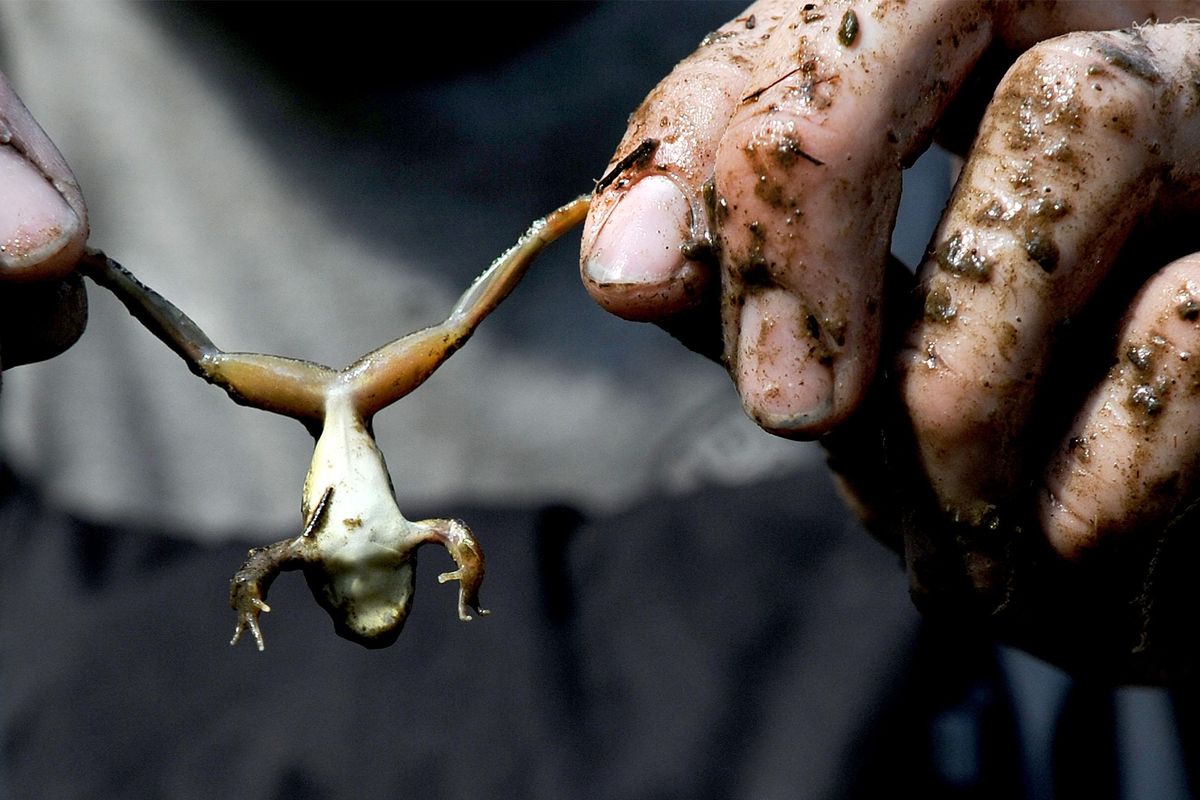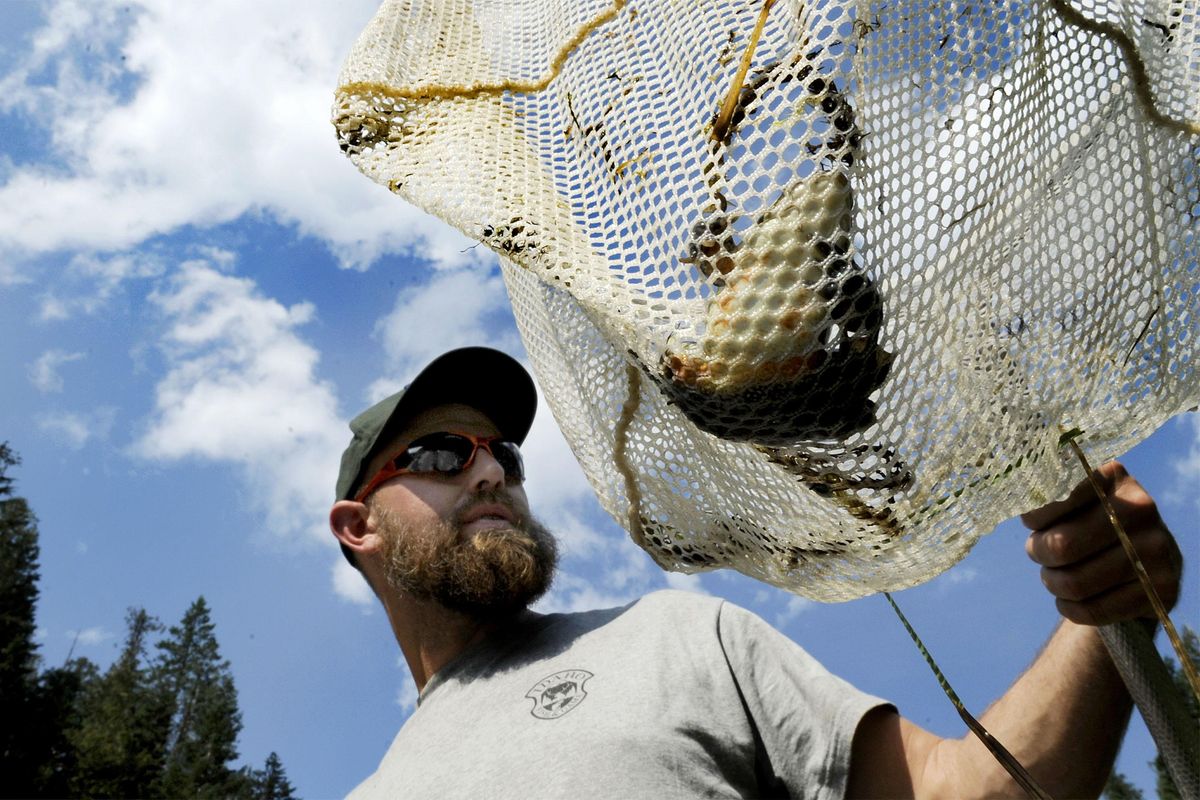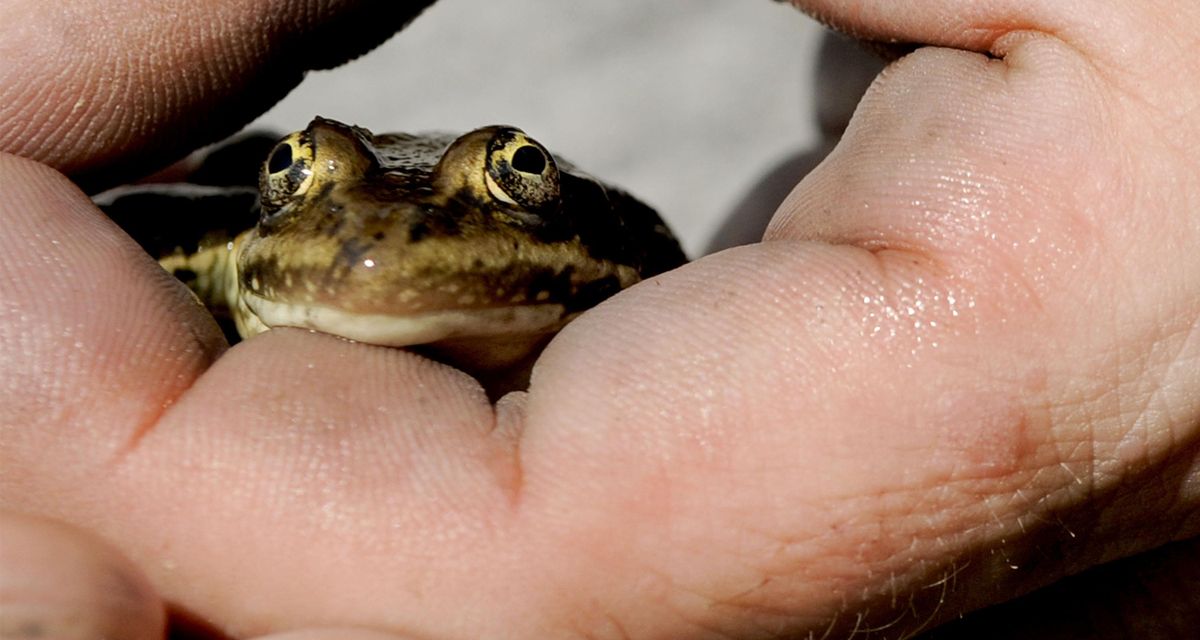Five years in the making, new survey catalogs nearly 200 species across the Idaho Panhandle
Michael Lucid, wildlife diversity biologist with ID Department of Fish and Game caught this frog in a small lake north of Priest Lake on Wednesday, September 4, 2013. He is heading up a multi-species baseline initiative study, figuring out how common or rare some little known species are in the Idaho Panhandle. (Kathy Plonka / The Spokesman-Review)Buy a print of this photo
Michael Lucid has scaled mountains and sifted through dead leaves on the forest floor in search of the Idaho Panhandle’s lesser-known creatures.
He’s set traps for beetles, learned to identify dozens of slugs and snails and recorded the stealthy movements of lynx and wolverines.
Along the way, he shed light on a century old wildlife hoax and discovered a new variety of jumping slug.
Lucid, an Idaho Department of Fish and Game biologist, recently wrapped up five years of research on what lives in the Panhandle’s forests, meadows and wetlands. He and two other state biologists led the work, which was done in cooperation with other government agencies, tribes, private landowners and volunteers, and spilled over into parts of Washington, Montana and British Columbia.
The research provides one of the most comprehensive records of local wildlife, where they live and what temperature zone they prefer. Nearly 200 species were detected at 2,300 survey sites across millions of acres of public and private lands. The animals ranged from tiny snails to 500-pound grizzlies.
The effort is unusual, because most wildlife monitoring focuses on a single species.
“Those guys deserve tremendous credit for being very visionary, in saying let’s look at the bigger landscape and survey some of these less glamorous animals,” said Lydia Allen, the Idaho Panhandle National Forests’ wildlife program manager.
Knowing where animals are found, particularly the rarer species, will help the Forest Service and other agencies as they plan for activities such as logging, recreation and prescibed burns.
The study also provides a benchmark for future scientists tracking changes in wildlife populations and habitat.
“We know a lot about elk and deer, but when you start looking for slugs and snails and frogs, there’s so much we don’t know,” said Cameron Heusser, wildlife program manager for the Coeur d’Alene Tribe, which participated in the survey work. “This is a start.”
The idea for the survey began several years ago, when Lucid and Allen met at a wildlife conference in Missoula.
At the time, wolverines were headed for protection under the Endangered Species Act. But the Idaho Panhandle National Forests didn’t have much information about the snow-loving critters, who live in the same harsh mountain environments that backcountry skiers prefer.
Allen was working on a winter recreation plan for the northern end of the forest. She came up with money for Idaho Fish and Game to do some wolverine monitoring.
Lucid and co-workers skied into remote areas to set up bait stations, wiring beaver carcasses to trees. A trail camera was set up to record what animals visited the site.
In addition to wolverine sightings, “we got some amazing pictures of lynx, which is a threatened species,” Allen said. There were also photos of flying squirrels and foxes, plus ermines, fishers and pine martens, seldom-seen forest carnivores that belong to the weasel family.
The bait stations produced so many wildlife images that Lucid started thinking about monitoring possibilities for a broad array of animals. The project morphed into an ambitious plan to survey wildlife across the Idaho Panhandle, with a focus on 19 lesser-known species.
Fish and Game biologists Lacy Robinson and Shannon Ehlers co-led the project with Lucid. Dozens of people from other state and federal agencies and tribes used Fish and Game’s protocol to conduct surveys and contribute to the data collection.
Volunteers also helped gather information, monitoring remote winter bait stations and sifting through bags of leaf litter for slugs and snails.
At many of the sites, air and water temperatures and relative humidity were recorded, helping identify the species’ climate needs.
Wildlife biologists tend to be reclusive introverts, toiling alone at their field work, Lucid said. But the survey work unleashed cooperation and camaraderie among the various partners, he said.
A $950,000 grant from the U.S. Fish and Wildlife Service helped fund the Fish and Game work. With contributions from other partners, the total project cost was about $2.6 million.
Slugs, snails and amphibians were some of the wildlife populations Fish and Game didn’t know much about. There’s also speculation that their porous skin and limited travel range could make them more vulnerable to a changing climate.
People often assign more value to larger animals, but each species plays a role in the ecosystem, Lucid said. Slugs and snails, also known as gastropods, help recycle the debris in the forest.
“If you can imagine a world where things never decomposed,” Lucid said. “We’d have meters of dry leaf litter and wood on the forest floor.”
Smaller creatures also provide food for larger animals. “They’re the prey base for the species we love,” he said.
Some animals thought to be extremely rare turned out to be fairly common. The magnum mantleslug, last documented in Lolo Pass in 1968, is widely, though thinly, distributed across the landscape, the surveys indicated.
The monitoring also uncovered a new variety of jumping slug. The slug’s uniqueness has been confirmed through DNA testing, though scientific recognition will require a published report in a peer-reviewed journal, Lucid said.
One of the snail subspecies Lucid was looking for led him to the odd tale of Henry Hemphill, a 19th-century gold prospector turned shell collector.
Hemphill sold snail shells to Eastern collectors, who paid a premium for each new species or subspecies. One of his catalogs listed a snail shell collected from the Idaho Panhandle in 1892.
But the surveys failed to turn up any of the snails. Lucid became skeptical that they existed.
“We dug through the literature, and we don’t think this species is taxonomically valid,” Lucid said. “Hemphill was monetarily motivated to expand his variety, so he could offer more specimens.”
Over a century, only two other sightings of the snail subspecies were recorded.
“It paints the picture that it really isn’t a species,” Lucid said. “We determined that he wanted another snail shell to sell.”
The monitoring work “gave us time to ask questions” instead of assuming old reports were factual, he said.
Idaho Fish and Game’s mission is to “protect, preserve and perpetuate” the state’s wildlife. Knowing what lives in North Idaho’s woods, ponds and wetlands helps further that goal, Lucid said.
“This type of information is really necessary to manage wildlife into the future,” he said.



